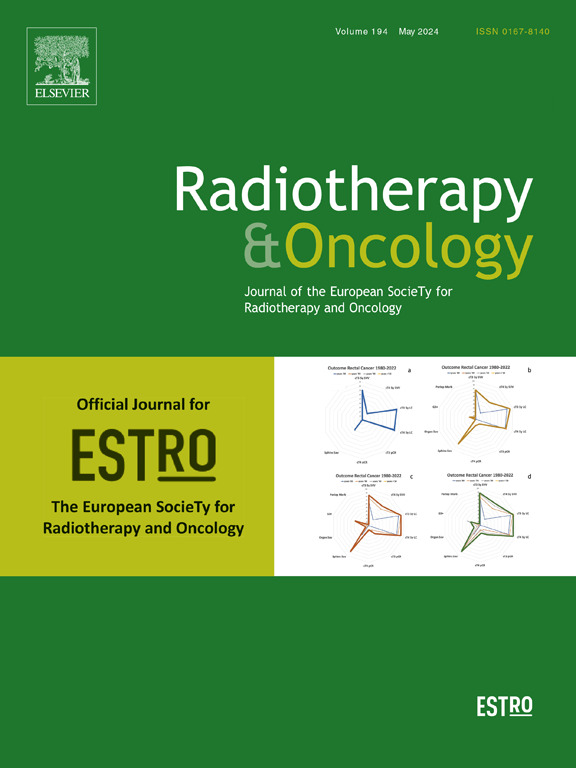多中心 III 期试验研究头颈部癌症的计划适应性放疗和剂量涂抹的协议遵守情况。
IF 4.9
1区 医学
Q1 ONCOLOGY
引用次数: 0
摘要
目的:报告头颈部癌症多中心 III 期试验中的质量保证(QA)和方案依从性(PA)情况,评估方案偏离的模式,并调查 PA 对研究结果的影响:本研究纳入了ARTFORCE试验(NCT01504815)的所有221名患者。治疗前和治疗过程中的质量保证措施包括方案指南、模拟运行、早期病例审查和试验会议。对试验组(eRT)患者的 FDG-PET 引导剂量绘制和计划自适应放疗进行了审查。研究了患者和疾病特征以及研究机构的应计率和时间与 PA 的相关性。采用 Cox 回归确定 PA 对结果的影响:所有九家研究机构都完成了虚拟运行,九家研究机构中有五家完成了早期病例审查,在221例患者中,有190例接受了早期病例审查。在所有随机接受 eRT 治疗的患者中,64% 的患者至少有一项实验内容出现偏差。方案偏差与患者接受治疗的机构有明显相关性(Cramer'sV 0.34-0.48)。尽管在 QA 中很早就发现了特定机构的偏差,但这些偏差在试验期间仍在继续。偏差与应计时间或应计率之间无明显关联(P ≥ 0.26)。在 eRT 中,实验 PA 与局部区域控制(LRC)(试验的主要终点)之间未发现明显关系(P≥.15):尽管进行了质量保证,但试验过程中仍存在方案偏差,这些偏差主要是针对特定机构的。然而,实验治疗策略的偏差并未对LRC产生重大影响,因此也未对试验结论产生重大影响。本文章由计算机程序翻译,如有差异,请以英文原文为准。
Protocol compliance in a multicentric phase III trial investigating scheduled adaptive radiotherapy and dose painting in head and neck cancer
Purpose
To report on quality assurance (QA) and protocol adherence (PA) in a multicentre phase III trial for head and neck cancer, evaluate patterns of protocol deviations and investigate the effect of PA on study outcomes.
Methods
All 221 patients from the ARTFORCE trial (NCT01504815) were included in this study. Pre- and per-treatment QA measures included protocol guidelines, a dummy run, early case reviews and trial meetings. FDG-PET-guided dose painting and scheduled adaptive radiotherapy were reviewed in patients in the experimental arm (eRT). Patient and disease characteristics, as well as institutes’ accrual rate and timing were examined for correlation with PA. Cox regression was used to determine the impact of PA on outcome.
Results
The dummy run was completed in all nine institutes and early case reviews were completed in five out of nine institutes that contributed 190 out of 221 patients. Among all patients randomized to eRT, 64 % had at least one deviation of the experimental trial components. Protocol deviations were significantly correlated with the institute patients were treated at (Cramer’sV 0.34–0.48). Despite early identification of institute-specific deviations in QA, these continued during the trial. No significant associations were seen between deviations and accrual timing or rate (P ≥ 0.26). Within eRT, no significant relation was observed between experimental PA and locoregional control (LRC), the primary endpoint of the trial (P≥.15).
Conclusions
Despite QA, protocol deviations persisted during the trial, which were mostly institute-specific. However, deviations of the experimental treatment strategy did not significantly impact LRC and therefore the trial conclusion.
求助全文
通过发布文献求助,成功后即可免费获取论文全文。
去求助
来源期刊

Radiotherapy and Oncology
医学-核医学
CiteScore
10.30
自引率
10.50%
发文量
2445
审稿时长
45 days
期刊介绍:
Radiotherapy and Oncology publishes papers describing original research as well as review articles. It covers areas of interest relating to radiation oncology. This includes: clinical radiotherapy, combined modality treatment, translational studies, epidemiological outcomes, imaging, dosimetry, and radiation therapy planning, experimental work in radiobiology, chemobiology, hyperthermia and tumour biology, as well as data science in radiation oncology and physics aspects relevant to oncology.Papers on more general aspects of interest to the radiation oncologist including chemotherapy, surgery and immunology are also published.
 求助内容:
求助内容: 应助结果提醒方式:
应助结果提醒方式:


